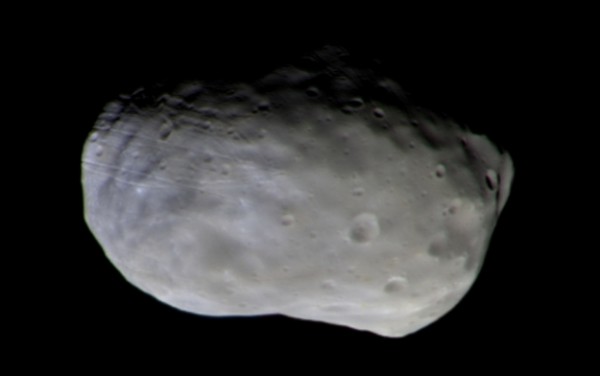By Ana Verayo, | December 29, 2016

Colour composite of Phobos taken with the ExoMars orbiter's Colour and Stereo Surface Imaging System. (ESA/Roscosmos/CaSSIS)
One of the elusive moons of Mars, Phobos, has been captured by a European probe in a new set of colored images, revealing the largest of the Martian moons.
Thanks to the European Space Agency's Trace Gas Orbiter, this new imagery was obtained by the probe which has been orbiting the Red Planet since mid-October. New views of Phobos was obtained when the TGO completed its second orbit of Mars.
Like Us on Facebook
The TGO is also part of the ESA's ExoMars mission. The probe flew over 4,784 miles above the surface of Phobos. Using the orbiter's CaSSIS (Colour and Stereo Surface Imaging System) camera, the collected images used four color filters revealing the mineral composition of the Martian moon.
According to ESA's TGO CaSSIS camera team's principal investigator, Nick Thomas, there are already high-resolution photos of Phobos from other missions such as NASA's Mars Reconnaissance Orbiter and ESA's Mars Express. However, this latest imagery tested data such as the camera's color calibration and internal timing.
To date, the ExoMars mission is testing its scientific instruments. Mission scientists are preparing the probe to shift into a closer and tighter scientific orbit around Mars by the end of 2017 via aerobraking.
During this mission, the TGO will collect measurements of rare gasses in Martian atmosphere such as methane, nitrogen dioxide, and acetylene which are less than one percent of the atmosphere's volume.
Mission scientists are particularly interested in methane since it also indicates biological signatures on Earth based on hydrothermal activity. Apart from this, ExoMars aims to detect hidden water or ice under the surface of the Red Planet by capturing high-resolution imagery.
The TGO will relay data from future rovers on the surface of Mars. The second phase of the ExoMars mission will see a Martian rover deployed by 2020.
-
Use of Coronavirus Pandemic Drones Raises Privacy Concerns: Drones Spread Fear, Local Officials Say

-
Coronavirus Hampers The Delivery Of Lockheed Martin F-35 Stealth Fighters For 2020

-
Instagram Speeds Up Plans to Add Account Memorialization Feature Due to COVID-19 Deaths

-
NASA: Perseverance Plans to Bring 'Mars Rock' to Earth in 2031

-
600 Dead And 3,000 In The Hospital as Iranians Believed Drinking High-Concentrations of Alcohol Can Cure The Coronavirus

-
600 Dead And 3,000 In The Hospital as Iranians Believed Drinking High-Concentrations of Alcohol Can Cure The Coronavirus

-
COVID-19: Doctors, Nurses Use Virtual Reality to Learn New Skills in Treating Coronavirus Patients







